Last week, a team of 100 musicians along with crew members gathered at the sprawling courtyard of The Rajbari Bawali to shoot the music video for SVF Music’s new song. Scheduled for release ahead of Durga Puja, this music video is SVF’s initiative to revive the nostalgia of music associated with Bengal’s biggest festival.
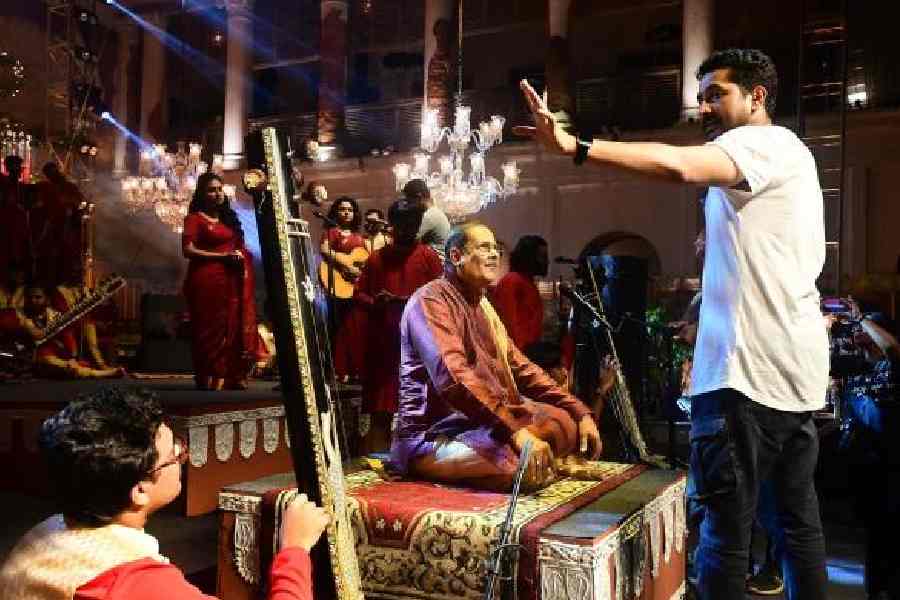
The song Charpashe aalo hok, composed by Indraadip Dasgupta, written by Srijato Bandyopadhyay and directed by Parambrata Chattopadhyay, will carry a message of hope and unity — the hope of welcoming light by pushing all the darkness away and staying together. t2 joined team Charpashe aalo hok for their one-day shoot with a grand set-up at The Rajbari Bawali, which was lit up in festive lights and immersed in celebrating the festive vibes, much ahead of the Puja days. Glimpses.

(l-r) Parambrata, Kaushiki Chakraborty
“My directorial journey started with two music videos for Tara Music in 2005. I was in my early 20s. I also conceptualised and directed the Ei shrabon song in Baishey Shrabon. On such a large scale, this is my first recording of a music video,” said Parambrata Chattopadhyay, when t2 caught up with him on the sets of the shoot. “SVF has come up with this wonderful idea, and they were very sure they did not want to tell a story involving three or four people. The idea was to make it look like an ensemble or a choir within our limited means, but we could make something grand out of it. We wanted to do a Puja song like a performance video that had not been done before. The entire video is just about the music, so we haven’t incorporated any fiction in this,” explained Parambrata about what his directorial lenses are trying to capture in this video. “For me, the structural cohesiveness of music acts as a tremendous trigger to make films in general. That was a big inspiration for me to shoot a music video,” he added. Recalling memories of Pujo-r gaan, he said: “Lots of nostalgic memories... it used to be a strange mix of both Bangla and Hindi songs. Pujo album used to be a big thing back in those days. It is not as big today, which is why the revival of Pujo-r gaan is very important.”
“My earliest memory of Pujo-r gaan is of the Durga Puja that used to happen at my house. And it was not done the typical way. Our family members used to do the puja and they all used to sing songs to explain the mantras. Everybody could understand what the rituals are all about. Also, in those years Pujo-r gaan used to be released separately as albums. Buying LPs and cassettes was important,” said Kaushiki Chakraborty. Her reason for agreeing to be a part of this project? “When I got to know that it is an all-night shoot, I regretted it. But ID is the first composer for whom I did any song outside of my classical music. When he said I had to do this, I couldn’t say no. I did not know how big the song was, or how many people were there. It feels good that different kinds of musical expressions are coming together in this song. It also means that different kinds of musical ideologies are coming together, which is obviously interesting. There are too many ideas that came together in this song, which signifies what Durga Puja has become for us… people across generations,” she said.

Somlata Acharyya Chowdhury (middle), (l-r) Anandi and Aheeri Chatterjee
“My fondest memory of Pujo-r gaan is listening to my own voice for the first time at a pandal. I have not done something of this scale before. I did not know that it was such a huge project; I got to know about it a few days before the recording. I didn’t even take a second to say ‘yes’. Indraadip Dasgupta has a definite soundscape, where we get to know that ID has composed the song. The melody is there, there is a tendency to go back to our roots and all of these make it a typical ID composition. There’s no challenge other than it being a full-night shoot,” said Somlata Acharyya Chowdhury.
For sister duo Anandi and Aheeri, who are attempting to create music as independent artistes, this recording is the first big project of their career, and so they are extremely excited. They said: “This is our first time in such a big project and working with SVF also. It is a great opportunity for us. We have always grown up listening to baba’s (Raghab Chatterjee) songs and his contemporaries Manomay Bhattacharya, Srikanta Acharya during Puja every year. We used to listen to the song Bhubono mohini a lot. We are extremely excited to get directed by Parambrata. It feels like getting a glimpse of being a part of a film shoot!”
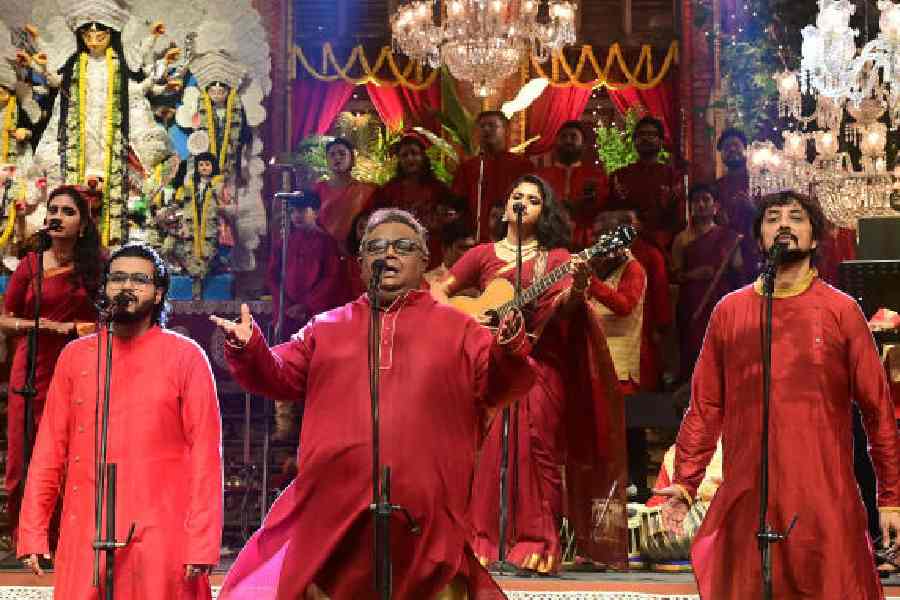
(R-L) Parthasarathi, Indraadip Dasgupta and Debayan Banerjee
“My idea behind doing this project was to promote independent Bangla music. Secondly, there’s a lot of disharmony among people after Covid. We are yet to see the light properly. Something or the other is taking over. This year we are a lot more safe but not completely. Maa is coming and she is the epitome of Shakti, we are praying for that Shakti to give us light. Let the world light up with that power,” explained Indraadip Dasgupta, who composed the song. Talking about the making, he said: “No matter what I do, apart from very specific film music, I try to make it a homage to Indian music. At the end of the day, I am Indian and Indian music is scientifically more enriched, without calling the other genres inferior. I was told it should be an amalgamation of many artistes. I have tried to make it a rainbow and spread it across. Indian music can also be grand is what we tried to show. We are all students of music and that is what we are trying. Srijato has written many songs for me. He understands my tunes very well. First the tune happened then the lyrics came. I thought someone should direct who is musically inclined and can also sing. After we requested Param, he said yes. I thought of Bawali Rajbari as the building is an amalgamation of modern finish and also ruins. This was a challenge and so I loved doing this. To fit them all, I required 11 minutes. For one song, 11 minutes is a lot. It took me three months.”
Debayan Banerjee, representing the contemporary generation of artistes in the video, said: “For me, Pujo-r gaaner memories is waking up to Kabir Suman’s songs on the para loudspeakers. It is all about absorbing the energy. This is a huge project. I have been working with Indraadip sir for the last one-and-a-half years, and it has been a great learning experience. The most challenging aspect of this project is to sing where Pandit Ajoy Chakrabarty and Kaushiki Chakraborty are there. The recording experience was brilliant.”
Parthasarathi, senior band member of Ekalabya, said: “Indraadip Dasgupta contacted me to be a part of this big song. It was a big honour for me that he gave me this opportunity. Then when I heard that Pt. Ajoy Chakrabarty and Kaushiki Chakraborty will be there, I considered myself really lucky. This conglomeration of different people from the Bengali music industry coming together is unique. And I think only Indraadip Dasgupta can create this magic and the synchronisation of so many different generations.”

Joy Sarkar, who will be seen playing the guitar and the Turkish string instrument saz in the video, said: “ Indraadip Dasgupta is my friend and I really like his work. Same for Srijato. We work together a lot. When ID told me that everyone is doing this together, I agreed to be a part of this immediately. SVF Music is doing a great job in releasing this from their platform. The song is associated with Durga Puja and it is a song of positivity. I enjoyed doing this work together with everyone. I had started my career as an instrumentalist before becoming a composer. ID wanted me as an instrumentalist in this video and that made me feel even better as I don’t get this opportunity any longer these days.”
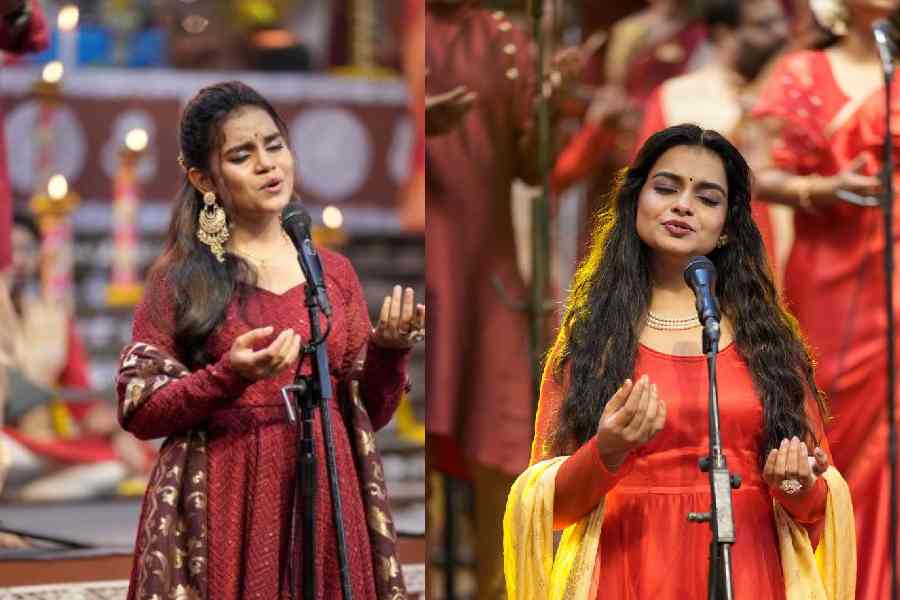
“This is the first time we are doing such a big project, and with so many big names in the industry. We learnt from Pt. Ajoy guruji and today we will perform with him too! Indraadip Dasgupta has been a mentor for us. We grew up listening to his music and always dreamt of singing for films. So, when he called us, we had to be a part of this project,” said the sister duo Antara and Ankita Nandy, who became an internet sensation with their songs and playing the ukulele. “As musicians, it is really exciting when we can’t predict what the next part of the song will be like and this composition is the same. It caters to every possible mood of a Pujo-r gaan. The right amount of celebration, fun and grandeur. The set is insane. The grandeur that we see in music videos, we are actually going to be in one of those videos that we have grown up watching. We had an opportunity to collaborate with Parambrata sir in the past but to be directed by him is a first. So we are super excited and very privileged,” added the sisters.
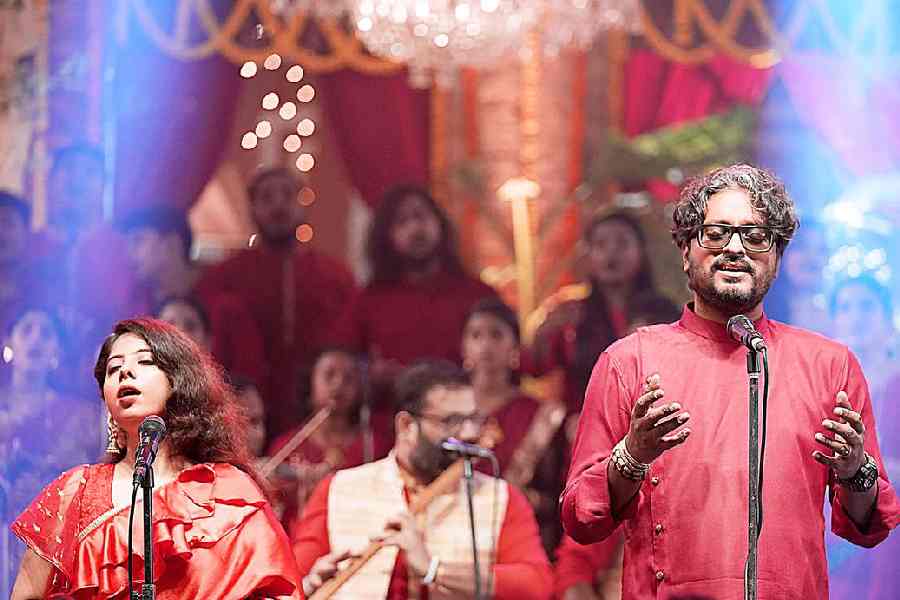
For Timir Biswas, lead singer of band Fakira, it was recording a Puja song after almost a decade. “I recorded a Puja song in 2013. During our growing up years, various artistes used to release their albums for Puja every year. For me, those are the best memories of Pujo-r gaan. Nowadays, artistes release their singles. Indraadip Dasgupta was my only reason to say yes to this,” he said.
Pujo-r gaan for Amrita Singh means listening to Kishore Kumar songs. “This is a new thing for me. I have not done this before. It is my first recording of a Puja song. This is my first work with Paramda as well. It was a very big song. The lyrics were almost two pages long. More than challenging, it is exciting for me since we are all working together,” said Amrita.
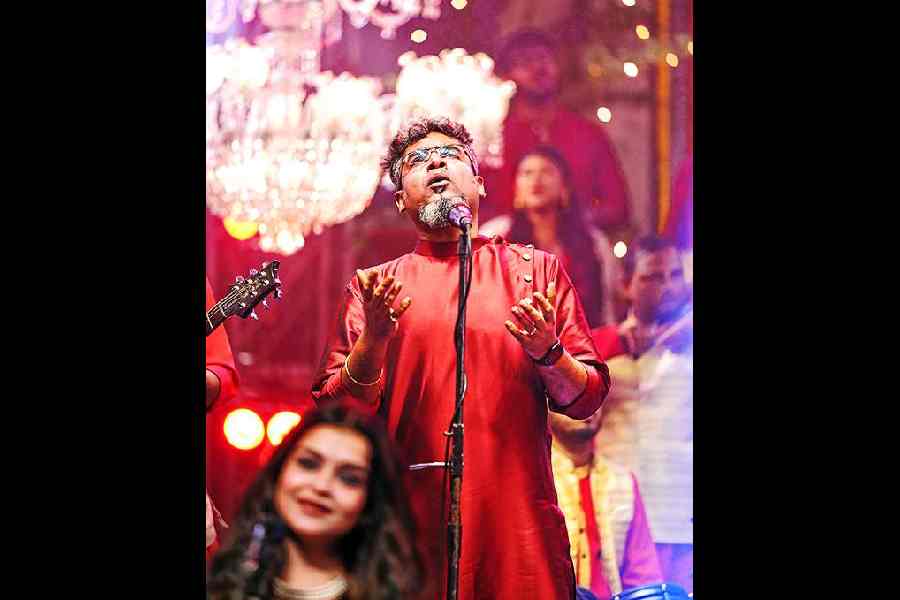
Koushik Chakraborty of the band Prithibi recalled what Pujo-r gaan meant during the ’90s. “It was the time of a transition from the generation before us and Bengali music went through a different change during that time. Kabir Suman, Nachiketa… that period is very nostalgic,” he said. He further spoke about why the shoot excited him in particular. “I have never seen a Rajbari puja since childhood. It is the first time I am getting to watch a Rajbari puja, that too before the Pujas. We have a US tour this year, so I will miss Puja, but no regrets as I got to see Puja before Puja started. Also, my professional stage career started with Indraadip Dasgupta’s judgement, so I had to be a part of this. I feel I am a bridge between the two generations that are here today,” said Koushik.










